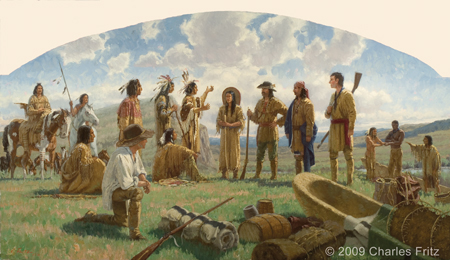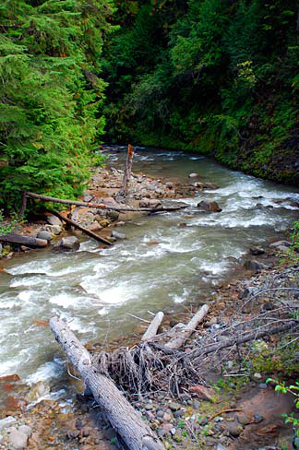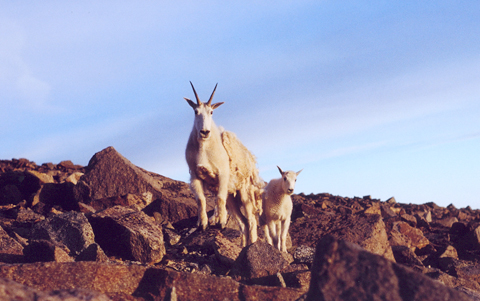A Wise Choice
Camp Fortunate, “Where we laid up our canoes”
36″ x 66″ oil on canvas
© 2009 by Charles Fritz, http://charlesfritz.com. Used by permission.
Moving right-to-left in this painting, Lewis speaks to Labiche who speaks to Charbonneau, who speaks to Sacagawea, who speaks to Cameahwait. To learn more about this translation chain, see 17 August 1805.
Captains Meriwether Lewis and William Clark were meticulous in selecting men for the expedition. They picked François Labiche because of his experience as a trader with the Indians along the Missouri; it is noteworthy that he was chosen as a member of the permanent party rather than just as a hired boatman. He proved his worth, not only in the boats but also as an invaluable link in the chain of communication with various tribes and in his great success as a hunter. Labiche was likely the son of a French-Canadian father and an Omaha Indian mother, and was probably born in eastern Nebraska. He was recruited at Fort Kaskaskia, in the Illinois country, and officially listed as a private in the Corps of Discovery on 16 May 1804 at St. Charles, Missouri.[1]The spelling of his name in the journals is variable: “La Buish,” “Leebice,” and several others. Labiche’s very name is also in doubt, because many French residents of … Continue reading
Labiche and Pierre Cruzatte were assigned to the third squad under Sgt. Nathaniel Pryor:
Labuche and Crusat will man the larboard bow oar alternately, and the one not engaged at the oar will attend as the Bows-man
It should be noted that those in the bow were second in importance only to the stern position. The bowmen looked ahead and recommended the line that the stern should steer the boat. Their position at the front of the boat also enabled them to assist with that steering when necessary.
‘Essential’ Translator
The captains named two rivers in honor of Labiche. As the expedition traveled down the Columbia on 29 October 1805, they passed Mount Hood and named a river flowing down its side for Labiche; it is now called Hood River. On the return voyage, when Labiche was with Clark’s party on the Yellowstone, the captain named a river on the north side for him; it is now Sarpy Creek.[2]Gary Moulton, The Journals of the Lewis & Clark Expedition, 13 vols. (Lincoln: University of Nebraska Press, 1983-2004) 1: maps 78, 111, 118; 5:352, 354n12, 378; 8:237, 240n3, 241n11.
Labiche’s knowledge of French, English, and several Indian languages were of primary importance to the captains in their communication with the tribes. His translation skills so impressed the Otoe Indians that they asked the captains to send Labiche on their behalf to make a peace treaty with the Pawnees, but the captains refused to release him.[3]Moulton 2:492.
During the winter at Fort Mandan, the captains hired Toussaint Charbonneau to accompany them westward because he would bring along one of his Shoshone wives, Sacagawea. The captains knew her services as a translator would be essential when the expedition reached her people at the continental divide, as they were the only source of horses to take them across the mountains. Sacagawea did not speak English, and Charbonneau was little better. Labiche therefore became an important link in the lengthy translation chain when the captains bargained with the Shoshone for horses. On 17 August 1805, the conversation went like this: Lewis spoke to Labiche in English; Labiche spoke to Charbonneau in French; Charbonneau spoke to Sacagawea in Hidatsa, and Sacagawea spoke to Chief Cameahwait in Shoshone. The conversation would continue in the reverse direction.[4]Moulton 5:111.
Labiche was essential once again when the expedition met the Salish on 4 September 1805. As Clark indicated the next day, communication with the Flatheads was through several interpreters, probably in this sequence: Lewis and Clark→Labiche→Charbonneau→Sacagawea→Shoshone guide Toby or his son→Salish.[5]Moulton 5:187-188.
Labiche’s skill in translation was so useful that Lewis wrote the following to Secretary of War Henry Dearborn on 15 January 1807:
He (Labiche) has received the pay only of a private, though, besides the duties performed as such, he has rendered me very essential services as a French and English interpreter; therefore, I should think it only just that some small addition to his pay, as a private, should be added, tho’ no such addition has at any time been promised by me.[6]Donald Jackson, ed., Letters of the Lewis and Clark Expedition with Related Documents, 1783-1854; 2nd ed.; 2 vols. (Chicago: University of Illinois Press, 1978), 1:367.
Reliable Hunter
Typically favoring rugged mountaintop terrain in the sub-alpine and alpine zones, especially where nearby cliffs provide safe havens for retreat from predators, this nanny and her kid were photographed on a sunny morning in early August at roughly 11,500 feet above mean sea level, in the Beartooth Mountains, a range that Clark would have observed from the banks of the Yellowstone River, but did not enter. This photograph underscores the main reason Lewis and Clark and their party never saw any live “fleecy goats.” As challenging as their crossing of the Bitterroot Mountains was, they never had reason to pick their way through such inhospitable rock gardens as this, even though Indians had told them that there were “a great number of white buffaloe or mountain sheep [that is, mountain goats] of the snowey hights” of the Bitterroot Mountains. (See also on this site Bighorn Sheep.)
—Joseph Mussuluman, ed.
Labiche was a skilled tracker and one of the best hunters in the Corps of Discovery. In 1804, as the expedition was heading up the Missouri, Labiche and three others were sent back down the river to search for deserter Moses Reed and to inquire about the missing La Liberté.[7]Moulton 2:455-456; 8:211.
While on the Lower Columbia River, Labiche’s skill at hunting was responsible for filling the plates and stomachs of the expedition members, perhaps more than any other hunter. On 18 November 1805, Labiche was with Captain Clark’s party as they explored the coast from Cape Disappointment up to present Long Beach, Washington. On that day, Labiche killed “4 brant and 48 Pliver.” During their winter at Fort Clatsop, Labiche and others were sent out hunting almost every day, and Labiche bagged a large number of elk.[8]Moulton 6:62, 66.
As the expedition worked its way home in 1806, Labiche was traveling down the Yellowstone River with Captain Clark and his party. On 3 August, Clark attempted to shoot a bighorn sheep but “the Musquetors were So noumerous that I could not Shute with any Certainty.” Clark sent Labiche to kill the ram, which he did. Labiche had proven his superior capability as a hunter once again.[9]Moulton 8:276.
After the Expedition
Sheheke and Yellow Corn
Charles B. J. F. de Saint Mémin (1770–1852) (altered)
Image combined from two separate portraits. Yellow Corn has been reversed. Original images courtesy Elizabeth DeMilt Fund, Collection of the New York Historical Society Museum.
Sheheke (“White Coyote”), the principal chief of the lower Mandan village, Mitutanka (or Matootonha), was nicknamed “Big White” by an unknown white man, evidently because of his size and relatively fair complexion. According to an observer at a New Year’s Day celebration at Washington City in 1807, Yellow Corn had “pretty features, a pale yellowish hue, bunches of ear-rings, and her hair divided in the middle, a red line running right across from the back part of the forehead.”
—Joseph Mussulman, ed.
Upon returning to St. Louis in September 1806, Labiche’s service did not end. After most of the members of the Corps of Discovery had said their farewells, Labiche and other former Expedition members were enlisted to travel with Meriwether Lewis to Washington, DC as escorts for Mandan Chief Sheheke (Big White) and Yellow Corn and his son; a delegation of Osage chiefs; Pierre Chouteau; and interpreter René Jusseaume, his wife, and his two children.[10]President Jefferson welcomed Sheheke to Washington with a speech on 30 December. After Sheheke and his family had arrived back in St. Louis, Nathaniel Pryor (by now an Ensign) and 14 soldiers (plus … Continue reading
Labiche was living in St. Louis along with his wife Genevieve Flore and 7 children between 1811 and 1834. In 1827, he signed a contract with Pierre Chouteau of St. Louis to serve as a “boatman, voyageur, and winterer” for the American Fur Company. Tax records in St. Louis show he was there in the 1820’s, and records of the fur trade show that he was still working in the mid-1830’s (when he was about 60 years old). His absence from the Missouri census of 1840 suggests that he had died by then.[11]Jackson 2:638; Larry E. Morris, The Fate of the Corps: What Became of the Lewis and Clark Explorers After the Expedition (New Haven: Yale University Press, 2004), 157-158, 195, 249n28.
Notes
| ↑1 | The spelling of his name in the journals is variable: “La Buish,” “Leebice,” and several others. Labiche’s very name is also in doubt, because many French residents of the era went by dit names, “dit” meaning “called.” These might begin as labels indicating place of origin, occupation, military rank, or even a personality or physical trait. But they were serious cognomens that could be passed from father to son, and used on legal documents. Gary Moulton suggests that Labiche’s true name may have been François Milhomme, dit Labiche. Moulton, 2:404n7, 518-519; 3:316n1. |
|---|---|
| ↑2 | Gary Moulton, The Journals of the Lewis & Clark Expedition, 13 vols. (Lincoln: University of Nebraska Press, 1983-2004) 1: maps 78, 111, 118; 5:352, 354n12, 378; 8:237, 240n3, 241n11. |
| ↑3 | Moulton 2:492. |
| ↑4 | Moulton 5:111. |
| ↑5 | Moulton 5:187-188. |
| ↑6 | Donald Jackson, ed., Letters of the Lewis and Clark Expedition with Related Documents, 1783-1854; 2nd ed.; 2 vols. (Chicago: University of Illinois Press, 1978), 1:367. |
| ↑7 | Moulton 2:455-456; 8:211. |
| ↑8 | Moulton 6:62, 66. |
| ↑9 | Moulton 8:276. |
| ↑10 | President Jefferson welcomed Sheheke to Washington with a speech on 30 December. After Sheheke and his family had arrived back in St. Louis, Nathaniel Pryor (by now an Ensign) and 14 soldiers (plus traders and fur trappers) were assigned to take Sheheke and his family back to the Mandan Villages. When the party reached the Arikara villages on 9 September 1806, they were turned back by an overwhelming attacking force. During the encounter, George Shannon was wounded in the leg, which was later amputated. A second attempt to return Sheheke and his family was begun in February 1809, and succeeded on 24 September, with Sheheke being back at his village more than three years after the expedition had left his village. Jackson 1:325n7; 2:382-383, 411, 432-438, 446-450, 456-458, 460-461, 484n2; Moulton 8:305-306. |
| ↑11 | Jackson 2:638; Larry E. Morris, The Fate of the Corps: What Became of the Lewis and Clark Explorers After the Expedition (New Haven: Yale University Press, 2004), 157-158, 195, 249n28. |




